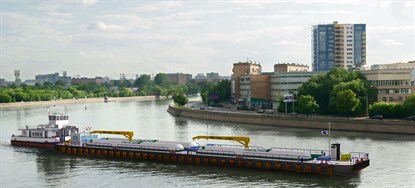Titan LNG develops LNG Bunkering pontoon in NW Europe

A 3D rendering of the Titan LNG Flex-Fueler in operation. Photo courtesy of Titan LNG.
Titan LNG, a supplier of LNG to the marine and industrial markets in northwest Europe, is developing a new solution for the safe delivery of LNG to both sea-going and river barges in ports in the ARA (Amsterdam – Rotterdam – Antwerp) region, Europe’s largest bunkering hub.
Following rigorous research and development, and based on its knowledge and experience in the bunkering and LNG sectors and based upon tried and tested technology, Titan LNG has designed and developed the first LNG bunkering pontoon in northwest Europe, the Titan LNG Flex-Fueler.
The ship is designed to have a fixed location to supply inland waterway vessels, but can also be navigated to larger sea-going vessels and safely supply LNG while they load or unload their cargo. The Titan LNG Flex-Fueler minimizes costs and maximizes operational efficiencies, while unlocking access to safe and quick LNG delivery in the ARA region. The Titan LNG Flex-Fueler is currently more economical than conventional LNG bunker barge delivery due to its low operational and capital expenditure requirements.
Niels den Nijs, Commercial Director, Titan LNG, commented, “It is critical that LNG bunkering infrastructure is developed to facilitate the efficient, cost effective, and safe delivery of LNG to both large and small LNG-fueled vessels. Currently, truck-to-ship delivery provides the most flexibility, and is the only means of receiving LNG bunkers in the ARA region. However, there is an increase in larger LNG-fueled vessels coming into the market, which cannot bunker at land-based LNG stations, as the deviation costs are too high or is simply not an option due to draft restrictions. The feedback that we have received from customers, ports and class societies has convinced us that Titan LNG Flex-Fueler is the missing link to safe, economical and speedy LNG delivery in the ARA region.
“The Titan LNG Flex-Fueler can act as a catalyst for a substantial increase in demand for LNG conversion – with current retrofitting costs decreasing as tanks and cryogenic equipment become cheaper due to economies of scale. We are working with other industry stakeholders, including ports, ship owners and operators as well as class to further develop the design and classification of the Titan LNG Flex-Fueler bunkering pontoon in advance of its official launch in Q1 2018.”
The Titan LNG Flex-Fueler boasts a double bottom, double hull with a length of 70 meters and will be fitted with up to four tanks, each with a capacity of 300 m3. Two cranes will be used for flexible hose guidance, and the discharge capacity range is between 30 and 450 m3/hr of LNG. Titan LNG Flex-Fueler is capable of loading and unloading via ex-wharf, ex-truck and ex-vessel.
The shipping industry is seeing an increase in demand for LNG and bunkering infrastructure in line with MARPOL Annex VI regulations that stipulates the requirement to burn clean fuel (with a sulfur content of less than 0.1%) in Emission Control Areas (ECA’s). A global 0.5% sulfur limit could be implemented as early as 2020. With the price of crude predicted to rise to $55/bbl from mid-2017, the return on investment (ROI) in switching to LNG is reduced to less than five years. The ROI will further accelerate as the global 0.5% sulfur limit is implemented in 2020, in conjunction with crude prices climbing to between $60/bbl and $80/bbl. This will act as a catalyst for a substantial increase in demand for LNG conversion, as new build and retrofitting costs are decreasing.

- ExxonMobil halts 1-Bft3d blue hydrogen project in Texas
- Aramco and Yokogawa commission multiple autonomous control AI agents at Fadhili gas plant
- Ukraine will resume gas imports via Transbalkan route in November
- Mitsubishi to inject $260 MM into Brunei LNG project
- Freeport LNG (U.S.) on track to take in more natgas on Thursday after unit outage



Comments